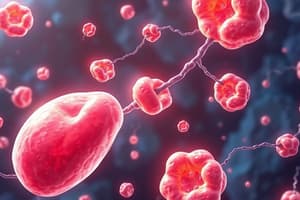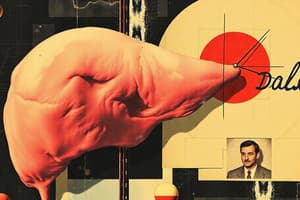Podcast
Questions and Answers
What is the role of triglycerides in the body?
What is the role of triglycerides in the body?
- To build cells of the nervous system
- To provide energy to the body when needed (correct)
- To flush out cholesterol from the body
- To produce vitamin D and hormones
What is the function of High-Density Lipoprotein (HDL)?
What is the function of High-Density Lipoprotein (HDL)?
- To carry cholesterol back to the liver to be flushed out of the body (correct)
- To increase the risk of cardiovascular disease
- To build plaque buildup in blood vessels
- To carry cholesterol that accumulates as plaque inside blood vessels
What is the result of plaque buildup in blood vessels?
What is the result of plaque buildup in blood vessels?
- Cardiovascular disease
- Atherosclerosis (correct)
- Heart attacks and stroke
- All of the above
What is the role of Apolipoprotein A in LDL particles?
What is the role of Apolipoprotein A in LDL particles?
What determines the levels of Lipoprotein A?
What determines the levels of Lipoprotein A?
What is the function of Very Low-Density Lipoproteins (VLDLs)?
What is the function of Very Low-Density Lipoproteins (VLDLs)?
What is the result of high levels of HDL in the blood?
What is the result of high levels of HDL in the blood?
What is the function of Intermediate-Density Lipoproteins (IDLs)?
What is the function of Intermediate-Density Lipoproteins (IDLs)?
What is the primary function of essential fatty acids in the membrane structure?
What is the primary function of essential fatty acids in the membrane structure?
Which of the following is NOT a function of essential fatty acids?
Which of the following is NOT a function of essential fatty acids?
What is the term used to describe the deterioration of fats and oils resulting in an unpleasant taste?
What is the term used to describe the deterioration of fats and oils resulting in an unpleasant taste?
Which of the following fatty acids is an omega-3 fatty acid?
Which of the following fatty acids is an omega-3 fatty acid?
What is the primary cause of oxidative rancidity?
What is the primary cause of oxidative rancidity?
Which of the following is a consequence of rancidity?
Which of the following is a consequence of rancidity?
What is the term used to describe the process of partial hydrolysis of triacylglycerols by bacterial enzymes?
What is the term used to describe the process of partial hydrolysis of triacylglycerols by bacterial enzymes?
Which of the following is a common source of linoleic acid?
Which of the following is a common source of linoleic acid?
What is the purpose of determining the acid number of an oil or fat?
What is the purpose of determining the acid number of an oil or fat?
What is the significance of a high saponification number?
What is the significance of a high saponification number?
What is the unit of measurement for iodine number?
What is the unit of measurement for iodine number?
What is the purpose of determining the Reichert-Meissl (RM) number?
What is the purpose of determining the Reichert-Meissl (RM) number?
What happens to the acid number of an oil or fat when it is contaminated or decomposed?
What happens to the acid number of an oil or fat when it is contaminated or decomposed?
What is the relationship between iodine number and the degree of unsaturation?
What is the relationship between iodine number and the degree of unsaturation?
What is the significance of a low iodine number?
What is the significance of a low iodine number?
What is the purpose of determining the saponification number of an oil or fat?
What is the purpose of determining the saponification number of an oil or fat?
What is the primary reason why the RM number is useful in testing the purity of butter?
What is the primary reason why the RM number is useful in testing the purity of butter?
What is the product of the reaction between fatty acids and alcohols?
What is the product of the reaction between fatty acids and alcohols?
What is the result of acid hydrolysis of esters?
What is the result of acid hydrolysis of esters?
What is the characteristic of the hydrocarbon tail of a soap molecule?
What is the characteristic of the hydrocarbon tail of a soap molecule?
What is the function of the micelles formed by soap molecules?
What is the function of the micelles formed by soap molecules?
What is the purpose of the RM number in butter?
What is the purpose of the RM number in butter?
What is a common consequence for individuals who inherit gene changes that make them more prone to high levels of lipoprotein A?
What is a common consequence for individuals who inherit gene changes that make them more prone to high levels of lipoprotein A?
What type of lipids undergo hydrolysis to produce derived lipids?
What type of lipids undergo hydrolysis to produce derived lipids?
Which of the following is NOT a function of lipids?
Which of the following is NOT a function of lipids?
Which vitamin is an example of a derived lipid?
Which vitamin is an example of a derived lipid?
What is the main function of lipids in cell membranes?
What is the main function of lipids in cell membranes?
Which of the following is a function of lipids in the improvement of taste and palatability?
Which of the following is a function of lipids in the improvement of taste and palatability?
What is the main function of lipoproteins in the body?
What is the main function of lipoproteins in the body?
Which of the following is NOT a precursor of steroid hormones?
Which of the following is NOT a precursor of steroid hormones?
Flashcards are hidden until you start studying
Study Notes
Cholesterol and Lipids
- Cholesterol helps the body produce vitamin D and hormones, including estrogen, testosterone, and cortisol.
- It also helps build cells of the nervous system.
- Triglycerides are produced by the liver and intestines and are stored in fat cells, released into the bloodstream when the body needs energy.
Types of Lipoproteins and Functions
- High-density lipoprotein (HDL) is the "good" cholesterol, carrying cholesterol back to the liver to be flushed out of the body.
- High levels of HDL reduce the risk of cardiovascular disease.
- Low-density lipoprotein (LDL) is the "bad" cholesterol, increasing the risk of coronary artery disease, heart attacks, and stroke.
- LDL carries cholesterol that accumulates as plaque inside blood vessels, leading to atherosclerosis.
- Very low-density lipoproteins (VLDL) are also bad cholesterol, carrying triglycerides and cholesterol to tissues.
- Intermediate-density lipoproteins (IDL) are produced when VLDLs give up their fatty acids, then either removed by the liver or converted into LDL.
- Chylomicrons are large particles that transport triglycerides.
- Apolipoprotein A (Apo(a)) is a type of LDL that makes particles stickier, increasing the risk of cardiovascular problems.
Derived Lipids
- Derived lipids are obtained through the hydrolysis of group 1 and 2 lipids, possessing characteristics of lipids.
- Examples include vitamin A, fatty acids, and steroids.
Functions of Lipids
- Lipids serve as a storage form of energy.
- They help in the absorption of fat-soluble vitamins.
- Lipids are a structural component of cell membranes.
- They act as thermal insulators, protecting internal organs.
- Lipids also act as electric insulators in neurons.
Essential Fatty Acids (EFAs)
- EFAs are required for membrane structure and function.
- They are necessary for the transport of cholesterol.
- EFAs are involved in the formation of lipoproteins.
- They prevent fatty liver disease.
- EFAs are also needed for the synthesis of eicosanoids.
Rancidity
- Rancidity is the deterioration of fats and oils, resulting in an unpleasant taste.
- Fats containing unsaturated fatty acids are more susceptible to rancidity.
- Rancidity occurs when fats and oils are exposed to air, moisture, light, and bacteria.
- Hydrolytic rancidity occurs due to partial hydrolysis of triacylglycerols by bacterial enzymes.
- Oxidative rancidity is due to oxidation of unsaturated fatty acids.
Test for Purity of Fats and Oils
- Acid number is the number of milligrams of potassium hydroxide required to completely neutralize the free fatty acids present in 1 g of the oil or fat.
- Saponification number is the number of milligrams of potassium hydroxide required to hydrolyze one gram of fat or oil.
- Iodine number is the number of grams of iodine absorbed by 100 g of fat or oil, indicating the degree of unsaturation.
- Reichert-Meissl (RM) number is the number of ml of 0.1 N potassium hydroxide required to completely neutralize the soluble volatile fatty acids distilled from 5 g of fat.
Chemical Reactions of Fatty Acids
- Esterification: reacts fatty acids with alcohols to form esters and water.
- Fatty Acid Hydrolysis: reverses esterification, producing fatty acids from esters.
- Saponification: base-catalyzed hydrolysis of an ester, producing an alcohol and a soap.
Studying That Suits You
Use AI to generate personalized quizzes and flashcards to suit your learning preferences.




